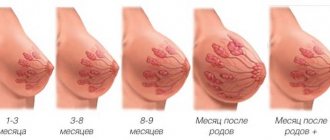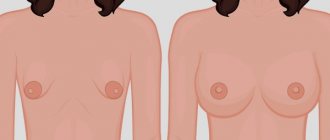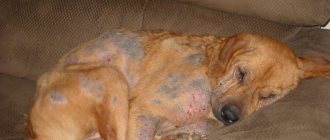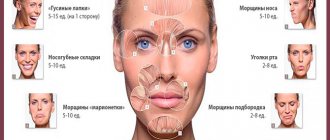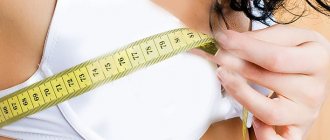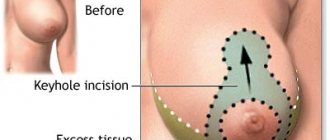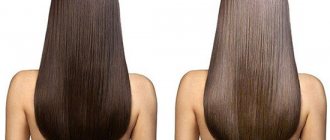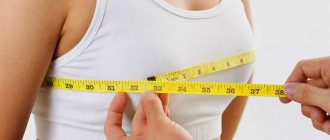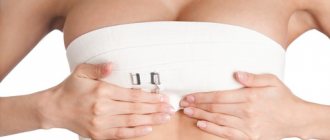When does bust growth begin?
So, let's figure out at what age do breasts begin to grow? It is impossible to give an exact answer to this question, since everything here depends on the individual characteristics of a particular organism. The growth of the mammary glands and the age at which this process occurs depends on hormonal levels. It often happens that by the age of 9-10 a girl already has noticeable roundness. In most cases, the process of bust enlargement is observed around 12-13 years.
Other indicators of puberty:
- The appearance of hair in the armpits and pubic area.
- Increased sweating in a girl.
- Beginning of menstruation.
- The hips and pelvis become more rounded.
- The daughter often becomes shy, withdrawn, and does not make contact with her parents.
During this period, it is very important to try to explain to the child that all the physiological changes that occur at this stage are a completely normal process and should not be embarrassed. It is better if the conversation is conducted by your mother or older sister.
Expert opinion
- Cosmetologist
- Surgeon
Irina Dorofeeva
practicing cosmetologist
Before puberty, a girl’s activity generally increases, and the occurrence of menstruation indicates a new stage of human development. It is at this time that active growth of the mammary glands is observed, but they begin to grow even earlier (several years in advance). On average, this happens around the age of 11, and most girls experience menstruation at 13-14 years old. If breast growth does not begin at this age, do not worry, since each body is individual. Sometimes this process occurs later.
Michelle Place
plastic surgeon
Breasts begin to form at the age of 10-12 years.
Often during this period, girls complain of itching as the skin stretches. Pain may also occur. Active growth of the mammary glands occurs later. If no changes are observed at the age of 16-18, you should consult a doctor to determine the cause. Thus, no matter what the breast size and the woman’s level of satisfaction with it, before resorting to decisive action, you need to consult a specialist, and also independently weigh the pros and cons.
And the most important thing that all women should remember is that you need to learn to accept yourself as you are and then others will treat you the same.
How to calculate the period of stopping breast growth in a girl?
To understand when approximately the process of increasing roundness should stop, doctors use a simple formula. It looks like this: the age at which menstruation began, plus 3-5 years. That is, for example, if a daughter’s period began at the age of 13, then by the age of 16-18 the bust should have already formed.
Expert opinion
Ksenia Dunaeva
User experience expert and comment moderator. Higher medical education and more than 5 years of actual practice.
Ask Ksenia
Of course, it cannot be said that after the growth of the mammary glands stops, they will not change in any way. Due to the fact that the breasts have a close connection with the girl’s hormonal background, with various fluctuations at this level, the bust may change slightly.
Truths and myths about breast growth
Cabbage has no effect on breast growth, but experts have proven that its consumption prevents the occurrence of malignant tumors and mastitis.
Physical exercise helps keep your bust beautiful and toned. So, push-ups and exercises with an expander are useful. This causes muscles to grow in the bust area, which makes the figure more prominent.
It is necessary to establish blood circulation in the bust area. It is not recommended to wear underwear that is tight. It is useful to periodically carry out professional breast massage.
There is an opinion that women's curves increase due to sex. The more a woman does it, the larger her bust. But experts say this is only partly true. To really make it grow, you need to first have a long period of abstinence, followed by intense lovemaking.
Another well-known myth is the use of contraceptives. Experts are confident that the woman will notice that her breasts have enlarged. There are reasons, but not all girls who use oral contraceptives notice this. In about a third of cases it remains unchanged. Some believe that in order to notice the effect, you should protect yourself in this way for a long period. As a result, the bust can grow even a couple of sizes.
But doctors do not recommend enjoying this phenomenon, because such an effect is only a side reaction to the pills. As soon as a woman stops drinking them, everything returns to its original state.
If this is observed, it can be stated that there is a hormonal imbalance. Therefore, you should not prescribe these pills yourself. Only a doctor, after performing tests, can tell you what is necessary in a particular case.
Stages of development
Having found out at what age girls’ breasts grow and what additional symptoms may appear, let’s look at what the stages of this process are. Despite the fact that this process occurs differently for all representatives of the fair half, depending on their hormonal background, there are still several identical stages. Let's find out more about them.
You might be interested in: What should a child be able to do at 5.5 years old?
From birth to 10 years
After birth, it is quite difficult to distinguish between the mammary glands of boys and girls. If you carefully examine the nipples of the fair half, you will see a barely noticeable milk line located slightly below the nipples. It is from this area that breasts will begin to form during puberty. By the age of 10 years, the breasts have a glandular base, slight roundness, and slight roughening of the nipples may be observed.
It often happens that immediately after birth, babies experience slight discharge from the nipples. This is a completely normal process and is not considered a pathology in medicine.
Puberty
Around the age of 13, a teenage girl's bust will begin to enlarge. At the same time, hormonal changes in the entire body are also noted. This can affect not only the external changes of the schoolgirl, but also her psychological state. In this case, minor painful sensations may be observed in the area of the mammary glands. This is explained by stretching of the tissues in this area.
In addition to pain, symptoms such as burning and itching may appear. Externally, the bust becomes more rounded and firmer. Now is the time to pick out your daughter's first bra. The underwear should not put too much pressure on the breasts, as during this period their intensive growth occurs. The bra should be made of natural fabrics. This will help eliminate irritation and allergic reactions.
Puberty
At this stage, the girl experiences intensive growth of the mammary glands and an increase in the volume of connective tissue. In this case, the breast looks like a cone, and a nipple is formed. Now a schoolgirl may experience the greatest degree of discomfort, since the growth of the bust is now the most intense. Unpleasant sensations occur during running and exercise.
It is interesting to note that there are cases where a girl’s bust increased by a whole size in a day.
Final period
After puberty ends, breasts stop growing. This occurs around the age of 15-17 years. By this stage, the milk ducts have completed their formation, and blood vessels can be visible through the skin of the breast. Gradually the unpleasant sensations pass. The nipples acquire a clear outline and become darker. The formed size remains stable until pregnancy. Sometimes bust growth can resume due to various endocrine diseases. If a schoolgirl experiences visible changes in this area, she should definitely consult a specialist.
You might be interested in: Child growth by month
What to do if your breasts don't grow
Every girl asked this question at least once at her tender age, when her figure is just beginning to take shape. At this age, and even with raging hormones in the body, young representatives of the fair sex are especially impressionable.
Some people later realize that a small bust is not a problem, and sometimes an advantage. For those ladies who don’t know what to do if their breasts are not growing, you can try the following:
- The fastest way, which, moreover, does not require extra effort. To increase volume, just go to a lingerie store and buy a bra with a push-up effect. Instant results are guaranteed. However, it can be very awkward when the deception is revealed to a man, and he will be upset not so much by the difference he saw, but by the fact that the girl he loved deceived him.
- You can give preference to a set of exercises. In this case, nothing can be done with the breast itself, since inside there are only mammary glands that rest in fat layers. And as you know, fat cannot be pumped up without surgery. But you can pump up your chest muscles. The most famous and simple exercise is called “prayer.” The hands are folded as in prayer, with the elbows pointing in opposite directions. Now we press both hands on each other at the same time. This simple exercise can be done anywhere and anytime. When doing physical exercise, it would be a big mistake to go on a diet - you can’t do this! You need to follow a balanced diet rich in proteins and carbohydrates.
- Medicine does not stand still and is actively developing in all directions that can help a person even with such a delicate issue as bust size. There is such an invention as vacuum nozzles. It is used as follows: a special cup is applied to each breast in turn, after which the air is pumped out of it. But the results from this method will not last long, only a few hours, but use can lead to problems with the health of the breast and sagging.
- Also on the cosmetology market there are many creams that help increase the coveted volumes. But you need to be careful with them, since most of them are hormonal. Therefore, the use of such drugs is possible only after consultation with your doctor.
- The most radical, expensive, but effective and at the same time dangerous method is plastic surgery. However, girls should remember that numerous surveys have shown that men in most cases like natural, medium-sized breasts.
Symptoms of breast growth
It is quite simple to recognize the period of active breast growth in a girl. The following changes occur:
- The appearance of pain and discomfort. Often a schoolgirl complains of itching and burning. With moderate pain, there is no need to worry, because this is a completely normal physiological process. If the pain is severe, it is necessary to show the child to the doctor.
- There is thickening and enlargement in the nipple area. This can be felt by touching.
- The halos become darker.
- The nipples become more prominent and can be easily seen through clothing.
- Light hairs may appear on the mammary glands. Don't worry, this is a completely normal process that occurs on a hormonal background.
- In the area of the halo, you can notice dots and tubercles. These are glands that are designed to moisturize the breasts. This is necessary during breastfeeding.
- It is quite natural if one of the mammary glands becomes slightly larger than the other.
To avoid stretch marks during intensive bust growth, it is necessary to use moisturizing cosmetics. A regular baby cream is suitable for this purpose.
Natural causes
The condition of the female breast is closely related to the reproductive system of the body. Any hormonal fluctuations immediately affect the mammary glands, most often leading to their enlargement and increased sensitivity. In some cases, swelling of the glands in women, pain, high sensitivity of the nipples and other symptoms are associated with two natural and safe causes. They are:
- Ovulation
In the middle of the menstrual cycle, ovulation occurs: a mature egg breaks out of the follicle and begins its journey through the fallopian tube. This process is accompanied by a sharp jump in female hormones in the woman’s body, which are necessary to prepare the uterus to receive a fertilized egg.
One of these hormones is estrogen, which has a powerful effect on breast fat and increases it. As a result, the nerve fibers are under pressure from the rapidly expanding tissue - therefore, breast enlargement is accompanied by pain and swelling. When menstruation occurs, pain and tension in the glands subside, and by the end of it all symptoms disappear completely.
If pregnancy occurs, it can become one of the earliest signals for a woman. The condition of the mammary glands is influenced by the same hormones - estrogens and prolactin. The first maintains the uterus in the desired condition, while the second is responsible for preparing the glands for the upcoming feeding of the baby. During pregnancy, the breasts can increase by 1-2 sizes during the first trimester, and along with it the nipple and the areola noticeably enlarge and darken. Vessels and veins also appear on the chest, which is associated with increased blood flow in this part of the body.
If the above conditions are the cause of painful enlargement of the mammary glands, there is no need to worry. Breast swelling before menstruation is one of the manifestations of PMS, which is a consequence of a slight hormonal imbalance. By consulting with a gynecologist, you can adjust your hormonal levels and get rid of the symptoms of premenstrual syndrome. When it comes to pregnancy, the situation is somewhat different: the process of bust enlargement is not only normal, but also mandatory - this is how the glands prepare for feeding.
What should parents do?
Faced with changes during puberty, many girls become scared and withdrawn. The mother’s task is to explain to her daughter that all the changes that happen to her should not cause embarrassment and fear.
It is important to talk to your child more often. The schoolgirl needs to be told that all these signs indicate that she is becoming a woman. Parents need to understand that one conversation will not be enough. You should support your daughter throughout the entire period, take an interest in her life and try to support her in everything.
When a girl gets her period, she stops growing
A couple of years passed before I saw Billy in my office again. Before the consultation, Amy said that Billie was teased at school for wearing a bra and that she got her first period before her tenth birthday. She was now among the tallest in her class. Billie, large for her age, sat in a chair at my desk. She was wearing dark baggy jeans and a black hoodie. Billie no longer swung her legs or looked around the office, but sat hunched over with her hands in the pockets of her sweatshirt.
“First of all, I'm worried about her rashes,” Amy said. “You can see them on the forehead, but they are also on the shoulders.
Her skin was shiny and dotted with small pustules. Billie sank into her chair as much as possible.
“I can help you with that,” I said and pulled the hood of my sweatshirt slightly to get a better look at the skin. - I will give you lotions, and if the situation does not improve within a couple of months, then come again - there are other remedies.
A feeling of relief crossed Billie's face, as if the sun had come out from behind the clouds, but she said nothing.
- Another problem with my knees. She starts having terrible pain when she runs or does physical education at school,” Amy continued. — Lumps appeared on them. Come on Billy! - she added slightly impatiently. — Show it to Doctor Francis.
Billie sighed, rolled up her jeans, and showed me her knees. She had dense bumps on her shins just below her kneecaps.
“That’s because you’re growing up very quickly now,” I said. “The fact is that your bones grow faster than your tendons.”
I pulled up the skeleton sitting in my office and pointed out where the patella tendon attaches to the tibia, then explained how stretching it could lift and irritate the bone.
“This disease even has a name,” I continued. “It’s called Osgood-Schlatter disease.”
Billie giggled.
The rate of bone growth from infancy through adolescence is relatively constant, but sex hormones, which begin to be actively produced at the onset of puberty, increase this rate. Tanner and Marshall showed that the "growth rate" graph in childhood is shaped like a ski jump: growth rate slows after infancy and then accelerates sharply in early adolescence.
Tanner and Marshall's notes are the epitome of dispassionate medical language, but there is an occasional note of humanity, indicating that the scientists were concerned not only about their research, but also about the anxieties that plague adolescents: “All the girls in the study reached their peak growth before the start of menstruation. We can confidently tell a tall girl who has already reached menarche that her growth will now slow down.”
Advertising
Causes of poor breast development
Sometimes it happens that a girl’s bust does not grow at all or its development suddenly stops. Such symptoms often indicate serious physiological disorders in the body, so they should never be ignored. It is important to show the teenager to a specialist. Most often, breast underdevelopment is associated with hormonal imbalance, namely a lack of female hormones called estrogens. Parents must understand that the sooner the problem is detected and timely treatment is begun, the greater the chances their daughter will have in the future as a mother.
Hormonal disorders are usually treated with hormonal medications. Intravenous or intramuscular injections are often required.
Alert
Unfortunately, enlarged mammary glands often signal the development of some disease. Moreover, the disease is not always associated with the glands themselves: the cause may also lie in pathologies of the genitourinary or endocrine systems. A particularly alarming sign is the disproportionately noticeable enlargement of only one breast in women - such a symptom requires immediate contact with a mammologist, since it often indicates the presence of both benign and malignant formations in the breast.
In general, all pathological causes of breast enlargement outside the menstrual cycle are as follows:
- The presence of a severe hormonal imbalance, due to which the norms of female hormones in the blood are exceeded.
- Disorders of the endocrine system - for example, diseases of the adrenal glands or thyroid gland.
- The presence of various diseases of the mammary gland: mastitis, mastopathy, cyst formation, cancer.
- Development of diseases of the genitourinary system: gynecological diseases of an infectious and inflammatory nature.
- If an uncharacteristic phase of the cycle has begun, or previously no changes in the gland were observed, but the breasts have enlarged, it is better not to delay with the thought “it will go away on its own” or, even worse, to self-medicate - you need to contact a mammologist.
- When the cause lies in hormonal imbalance or endocrine system disorders, timely hormonal therapy can restore balance and return the breast to its normal state. If any breast disease is detected, treatment will depend on the stage of the disease: in the initial stages, conservative treatment is effective, but in advanced cases, surgical intervention may be required.
- And finally, gynecological diseases of various types are cured with individual methods and medications, after which the bust usually restores its previous shape.
Basic methods of treating breast growth retardation
It's no secret that the size and shape of the bust largely depends on heredity. As a rule, mothers with gorgeous breasts give birth to daughters, who later also develop roundness of size 3-4. And thin women with neat breasts give birth to daughters with modest shapes.
Of course, it is unlikely that you will be able to somehow influence the size, since you cannot go against genetics, but it is quite possible to adjust the elasticity and shape of the roundness. In addition to proper medical treatment, it is important to follow some methods to help cope with the problem of poor bust development.
Introduction of special foods into the diet
Proper and balanced nutrition promotes healthy development of the mammary glands. During this period, you should introduce foods into your diet that will help you cope more easily with puberty and the period of active breast growth. Consider these dishes:
- All types of lettuce and greens.
- Walnuts, hazelnuts, cashews.
- Pumpkin, persimmon, avocado, mango.
- Cabbage, beans and grains, as they contain large amounts of folic acid.
- Vegetables and fruits with orange and red tints.
- Purified water in sufficient quantities.
You might be interested in: How to choose skis for children according to height
These products have a positive effect on women's health and help shape the bust. To maintain elastic and clear skin, the girl is recommended to avoid eating foods that are too fatty, smoked meats, lard, fast food, and alcoholic beverages.
Physical exercise
To maintain elastic and beautiful skin during puberty, it is very important for schoolgirls to maintain sufficient physical activity. Exercises such as swimming, yoga, athletics, and gymnastics will help. Doctors recommend avoiding strength training and risky sports. To strengthen the mammary glands, exercises such as push-ups and jumping rope will be useful.
Playing sports is allowed only in those cases. If the girl has no contraindications. At the same time, to achieve visible results, training should be carried out regularly.
Timely visit to the mammologist
Starting from puberty, it is very important that the girl regularly visits specialists such as a gynecologist and mammologist. Doctors recommend such visits at least once a year. If any negative symptoms develop, for example, pain, you should make an appointment with a specialist as a matter of urgency.
What causes early puberty?
Tanner and Marshall described the participants as "white British" who "had no physical disabilities and lived in small family groups in a children's home." However, these children "mainly came from the lower socioeconomic strata of the population, and some of them did not receive good care before entering the orphanage (usually between the ages of 3 and 6)."
It is known that children who start life in a disadvantaged environment and then end up in a prosperous environment reach puberty earlier than those who did not change their environment. Poor childhood care and low birth weight in unknown ways accelerate the onset of puberty, as if evolution in response to a stressful childhood promotes pregnancy as early as possible. This process is called “early life programming.”
In Tanner's children, puberty may have started earlier precisely because of this mechanism. Thus, his findings were not representative of other populations.
The same thing happens in plants: those that began to grow in poor soil and then were transplanted into fertile soil begin to bloom earlier and more abundantly. At the same time, the average age at menarche, that is, a girl's first menstruation, in the United States and Western Europe fell from seventeen years in the mid-19th century to thirteen years in the mid-20th century. What this is connected with is still unknown.
Billie was still young for the first signs of puberty, but according to Tanner's charts, her development was quite normal. At an early age she was at the lower limit of normal growth, and now she is at the lower limit of normal for the onset of puberty: the second, noticeable stage of mammary gland development can begin at just eight and a half years. Perhaps life before adoption triggered early maturation, or perhaps her biological mother experienced the same thing.
What influences the process of breast growth?
A variety of provoking factors can affect features such as the size and shape of a girl’s mammary glands. These include:
- Genetic predisposition. The likelihood of having a girl who will later develop a large bust in a family where all the women had chic shapes is much higher.
- Features of hormonal levels. The presence or absence of various diseases of the endocrine system. With insufficient amounts of female hormones, breast growth may slow down or be completely absent.
- Child nutrition. In schoolgirls who are too thin, due to a lack of adipose tissue, bust growth may slow down. It is important for parents to ensure that their daughter receives complete and balanced nutrition.
The speed of the process of formation of mammary glands can also be affected by such features as the region of residence, environmental conditions, playing sports or lack of normal physical activity, nutrition and much more.
How to stimulate breast growth
Breast growth occurs during puberty and is limited to this time. Therefore, if you want to have a magnificent bust, you must try to make the most of the period allotted by nature. There are several methods for this. Although their effectiveness has not been scientifically proven, you can try:
- Proper nutrition for breast growth. You can't limit your fat intake too much. Many girls, dreaming of a slim figure, radically cut back on their diet. This leads to a lack of fatty tissue on the body, instability of the menstrual cycle and slower breast growth. Therefore, you should definitely consume healthy fats in moderation, found in olive oil, nuts, fish, avocado and dairy. You should also include foods rich in phytoestrogens in your diet. This is a plant analogue of the female hormone, which is found in pumpkin, beans, eggplant and flax seeds. There is a lot of it in soy dishes. It is very important to avoid foods that trigger testosterone production. This is a male sex hormone that slows down breast growth. Its production in the body accelerates after eating chips, crackers, baked goods and other foods rich in carbohydrates.
- Specially selected physical exercises. You need to choose something that strengthens the spine and improves posture, such as Pilates or yoga. It is necessary to select loads with the help of a trainer, otherwise there is a high risk of making a mistake and, conversely, slowing down the growth of the bust.
- Light chest massage. It can theoretically increase blood flow to this organ, and therefore stimulate its growth.
- Taking estrogen-containing birth control pills. You can consult your doctor about taking such medications. Slow breast growth is often associated with hormonal imbalance. Contraceptive medicine will help correct it and enlarge the bust.
You can also try some manipulations with your bra. Firstly, there is an opinion that giving up this wardrobe item stimulates bust growth. Secondly, if you can’t do anything with the size yet, you can choose underwear with a push-up effect.
Sometimes it is advised to stimulate breast growth with herbal decoctions. But this is too risky. The effectiveness of herbal preparations is very low, and the likelihood of side effects is too high.
Let's sum it up
The development of a girl, especially during puberty, is a rather complex and multifaceted process that requires special attention from parents. As a rule, the growth and development of breasts in schoolgirls begins at 12-13 years of age and ends at 15-18 years of age.
These terms depend on the individual characteristics of the body and some other factors that we discussed above in the article. The parents’ task is to support their daughter in everything and explain to her that all the changes that occur during this period are completely natural and should not be ashamed of them.
What time do breasts begin to grow?
I met Billie Baxter when she was four, after two of my longtime patients adopted her. She was small for her age, curious and lively, with short blond hair that curled around her neck. When she walked into my office, she went straight to the toy mat and then jumped on the scale. Her mother Amy worked as a librarian, and her father Simon looked after Billy at home.
Ear infections, lung infections, constipation, eczema—I saw Billy a lot the first couple of years. She remained petite for her age.
If you measure the height and weight of one hundred children and enter the data into a table, you will see a range of “normal” indicators that stretches between the third child from the beginning and the third from the end, that is, between the third percentile and the 97th, respectively. Billie remained in the fifth percentile, which is the lower limit of normal. Her curiosity never left her: in kindergarten she was among the smartest, and when she went to school, she turned out to be a passionate lover of reading. Little was known about her biological parents.
I never got to visit Simon and Amy at home, and by the time Billie turned six, the frequency of her visits to the clinic had dropped dramatically.
A couple of years later, when Billie was eight, I saw her name again on my patient list. She sat down on a chair by my desk, began swinging her legs and looking around the office, as if recalling her childhood visits. She was wearing unicorn pants and a kitten sweater; her hair, darkened over the years, was combed into a ponytail. She was of average height for her age—must have been close to the 50th percentile.
“I brought her in for a consultation about her toes,” Amy said. “Nails grow in the corners.” Billie took off her sneakers—she had glitter polish on each nail—and I showed her how to lift the corners of her nails with a piece of cotton so they wouldn't grow into the flesh. When I finished and Billie had put her socks and sneakers back on, Amy asked her to leave the office and wait outside.
“I wanted to talk to you alone,” Amy said as soon as the door closed. — At what age does puberty usually begin?
“Well, it depends...” I began.
“It’s just that I was twelve when I got my period,” Amy said.
— Has Billy started his period?
- No, but her breasts have already begun to grow. She's only eight!
Has she already developed pubic hair? - I asked.
She shook her head.
- No, thank God. It's too early, isn't it?
Physiological pain
Physiological chest pain is normal in nature, so there is no need to worry in this case. It has long been known that changes regularly occur in the soft tissues of the female breast, which primarily depend on the production of the following types of hormones:
- Estrogen or estradiol. Responsible for the development and functioning of the thoracic ducts. If estradiol is produced in excess, the risk of breast atrophy and an increase in the amount of fat deposits in soft tissues increases.
- Progesterone. Thanks to him, a woman is capable of lactation. Progesterone is responsible for the development and functioning of the alveolar lobes. With its deficiency, the development of pathological abnormalities in the chest is possible.
- Prolactin and oxytocin. These two types of hormone play a very important role in the functioning of the female body. The first one favors the production of milk, and the second one is responsible for its release.
Hormonal imbalances
With a sharp change in hormonal levels, other diseases may arise that will relate to a non-gynecological profile. Among such ailments, hepatitis, cirrhosis of the liver and frequent nervous tension and stress are particularly dangerous.
Diagnosis of cancer cannot always be made in its initial stages. However, without yet knowing about the presence of a serious illness, unpleasant sensations may appear in the mammary glands, and the nipples may begin to swell and increase in size. In the initial stages of cancer, pain may resemble symptoms of mastopathy. Therefore, it is very important to pay attention to any unusual discomfort in the chest.
The presence of a malignant neoplasm can be suspected if the lump is very closely fused to the breast and touches the nipples; also, discharge mixed with blood or pus may indicate cancer.
Why is it important to carry out regular independent palpation of the glands? According to gynecologists and mammologists, this procedure will prevent the development of serious abnormalities in the functioning of the mammary glands. This will also make it possible to start timely treatment and avoid possible complications of the disease. In any case, chest pain is not a simple phenomenon, which sometimes requires special attention and control!
Physical training
And finally, another reason is physical activity. More precisely, active sports. With regular training, the pectoral muscles are effectively strengthened, which much better support the entire breast (there are no muscles in the structure of the gland itself).
A woman may not pay attention or not notice changes in this area for a long time - especially if the goal of the training was at a different point. It should also be clarified that the breasts do not so much become larger as they are tightened and take on a natural and more beautiful shape. By combining physical activity with proper massage, you can achieve incredible results.
Every woman dreams of beautiful, lush and firm breasts. An unexpected and sharp enlargement of the mammary glands, alas, does not at all seem like a dream come true - rather, on the contrary, it causes great anxiety.
There are many reasons for this phenomenon. Some of them are associated with natural states of the body, such as ovulation, pregnancy or the postpartum period. Other reasons may indicate serious hormonal imbalances, the presence of gynecological diseases or breast diseases. The condition and shape of the breasts can be affected by diet, exercise, or fluctuations in body weight. In any case, if enlarged breasts cause concern, you should immediately consult a doctor in order to avoid more serious consequences in time.
Today, almost every woman has had to deal with chest pain, as well as enlarged mammary glands. Perhaps the fair half of the population most often turns to gynecologists with such problems. If your breasts hurt or are enlarged, this does not necessarily mean that the woman is susceptible to a serious illness.
In some situations, chest pain and enlargement of the mammary glands are absolutely natural processes, because the condition of the female breast directly depends on the direction and development of its hormonal levels. It is for this reason that chest pain can be divided into physiological and pathological.
In order to understand what is within the norm and what you need to be wary of, let’s take a closer look at each of the options.
Until what age do girls' breasts grow?
As you know, puberty in girls is accompanied by a number of changes associated with hormonal changes in the body. The first menstruation appears, the menstrual cycle is established, the mammary glands begin to enlarge, female-type hair growth gradually appears, weight and psycho-emotional state changes, etc.
Often the above changes are accompanied by dissatisfaction on the part of the girl. Firstly, not everyone likes their appearance, which changes under the influence of hormones. Secondly, every girl begins to compare herself with her friends and classmates, finding new, in her opinion, shortcomings in herself. Some people have a complex about the rapid growth of their breasts, while others, on the contrary, cannot wait until their size can catch up with the size of their classmates. A girl at puberty feels insecure and uncomfortable in her own body.
